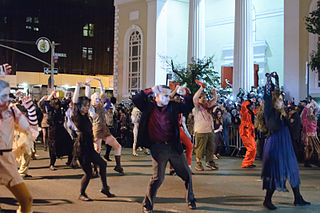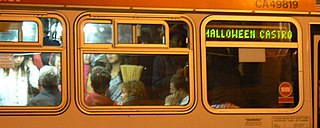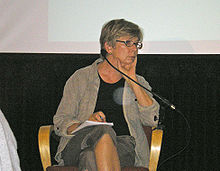Costume is the distinctive style of dress or cosmetic of an individual or group that reflects class, gender, profession, ethnicity, nationality, activity or epoch. In short costume is a cultural visual of the people.

Halloween or Hallowe'en is a celebration observed in many countries on 31 October, the eve of the Western Christian feast of All Saints' Day. It begins the observance of Allhallowtide, the time in the liturgical year dedicated to remembering the dead, including saints (hallows), martyrs, and all the faithful departed.

Carnival is a Catholic festive season that occurs before the liturgical season of Lent. The main events typically occur during February or early March, during the period historically known as Shrovetide. Carnival typically involves public celebrations, including events such as parades, public street parties and other entertainments, combining some elements of a circus. Elaborate costumes and masks allow people to set aside their everyday individuality and experience a heightened sense of social unity. Participants often indulge in excessive consumption of alcohol, meat, and other foods that will be forgone during upcoming Lent. Traditionally, butter, milk, and other animal products were not consumed "excessively", rather, their stock was fully consumed as to reduce waste. This festival is known for being a time of great indulgence before Lent, with drinking, overeating, and various other activities of indulgence being performed. For example, Pancakes, donuts, and other desserts are prepared and eaten for a final time. During Lent, animal products are eaten less, and individuals have the ability to make a Lenten sacrifice, thus giving up a certain object or activity of desire.

A fan or fanatic, sometimes also termed an aficionado or enthusiast, is a person who exhibits strong interest or admiration for something or somebody, such as a celebrity, a sport, a sports team, a genre, a politician, a book, a movie, a video game or an entertainer. Collectively, the fans of a particular object or person constitute its fanbase or fandom. They may show their enthusiasm in a variety of ways, such as by promoting the object of their interest, being members of a related fan club, holding or participating in fan conventions or writing fan mail. They may also engage in creative activities such as creating fanzines, writing fan fiction, making memes or drawing fan art.

The Llangollen International Musical Eisteddfod is a music festival which takes place every year during the second week of July in Llangollen, North Wales. It is one of several large annual Eisteddfodau in Wales. Singers and dancers from around the world are invited to take part in over 20 competitions followed each evening by concerts on the main stage. Over five thousand singers, dancers and instrumentalists from around 50 countries perform to audiences of more than 50,000 over the 6 days of the event.

Junkanoo is a street parade with music, dance, and costumes with origin in many islands across the English speaking Caribbean every Boxing Day and New Year's Day. These cultural parades are predominantly showcased in the Bahamas where the music is also mainstreamed, and competition results are hotly contested, There are also Junkanoo parades in Miami in June and Key West in October, where local black populations have their roots in the Caribbean. In addition to being a culture dance for Afro-North Carolinians and the Garifuna people, this type of dancing is also performed in The Bahamas on Independence day and other historical holidays.

The Toronto Caribbean Carnival, formerly known as Caribana, is a festival of Caribbean culture and traditions held each summer in the city of Toronto, Ontario, Canada. It is a pan-Caribbean Carnival event and has been billed as North America's largest street festival, frequented by over 1.3 million visitors each year for the festival's final parade and an overall attendance of 2 million.

The Carnival of Brazil is an annual Brazilian festival held the Friday afternoon before Ash Wednesday at noon, which marks the beginning of Lent, the forty-day period before Easter. During Lent, Roman Catholics and some other Christians traditionally abstained from the consumption of meat and poultry, hence the term "carnival", from carnelevare, "to remove meat."

The West Side Nut Club Fall Festival is an annual event held the first full week of every October on Franklin Street in Evansville, Indiana, and is organized by the West Side Nut Club. The festival features over 136 food booths run and operated by not-for-profit groups in the region. It features an eclectic variety of food, particularly both traditional and unique fried food. The festival also includes numerous forms of entertainment, carnival attractions, amateur talent competitions, and a parade.

A costume party or fancy dress party is a type of party, common in contemporary Western culture, in which many of the guests are dressed in costume, usually depicting a fictional or stock character, or historical figure. Such parties are popular in the United States, United Kingdom, Canada, Australia, Ireland and New Zealand, especially during Halloween.

The Village Halloween Parade is an annual holiday parade on the night of every Halloween, in the Greenwich Village neighborhood of New York City. The parade, initiated in 1974 by Greenwich Village puppeteer and mask maker Ralph Lee, is the world's largest Halloween parade and the only major nighttime parade in the United States. The parade reports itself to have 50,000 "costumed participants" and 2 million spectators.

The Carnival of Barranquilla is one of Colombia's most important folkloric celebrations, and one of the biggest carnivals in the world. The carnival has traditions that date back to the 19th century. Four days before Lent, Barranquilla decks itself out to receive national and foreign tourists to join together with the city's inhabitants to enjoy four days of intense festivities. During the carnival, Barranquilla's normal activities are put aside as the city gets busy with street dances, musical and masquerade parades. The Carnival Of Barranquilla includes dances such as the Spanish paloteo, African Congo, and indigenous mico y micas. Many styles of Colombian music are also performed, most prominently cumbia, and instruments include drums and wind ensembles. The Carnival of Barranquilla was proclaimed a Cultural Masterpiece of the Nation by Colombia's National Congress in 2002. Also the UNESCO, in Paris on November 7, 2003, declared it one of the Masterpieces of the Oral and Intangible Heritage of Humanity, and it was during Olga Lucia Rodriquez Carnival Queen year.

The Festival interceltique de Lorient (French), Emvod Ar Gelted An Oriant (Breton) or Inter-Celtic Festival of Lorient in English, is an annual Celtic festival, located in the city of Lorient, Brittany, France. It was founded in 1971 by Polig.

The Celtic and Irish Cultural Society promotes and supports awareness of Irish and Celtic culture in Crawley, West Sussex and throughout the southeast of England.

Halloween in the Castro was an annual Halloween celebration held in The Castro district of San Francisco, first held in the 1940s as a neighborhood costume contest. By the late 1970s, it had shifted from a children's event to a gay pride celebration that continued to grow into a massive annual street party in the 2000s.

Halloween is a celebration observed on October 31, the day before the feast of All Hallows, also known as Hallowmas or All Saint's Day. The celebrations and observances of this day occur primarily in regions of the Western world, albeit with some traditions varying significantly between geographical areas.
Numerous events and festivals are held annually in Metro Manila. They include:

The Festivity of La Mare de Déu de la Salut is a festival celebrated in Algemesí (Valencia), Spain, from August 29 to September 8. The festival is in honour of the patron saint of Algemesí, La Mare de Déu de la Salut, and has been dated back to 1247. The holiday was awarded the UNESCO "Masterpieces of the Oral and Intangible Heritage of Humanity" designation on November 28, 2011.

Etnovyr is the annual International Folklore Festival that has taken place in Lviv on the eve of Ukraine Independence Day since 2008 under the auspices of International Council of Organizations of Folklore Festivals and Traditional Arts (CIOFF) under UNESCO and is organised by Non-governmental organization "Etnovyr" and Event Management Company. The festival takes place in downtown.


















